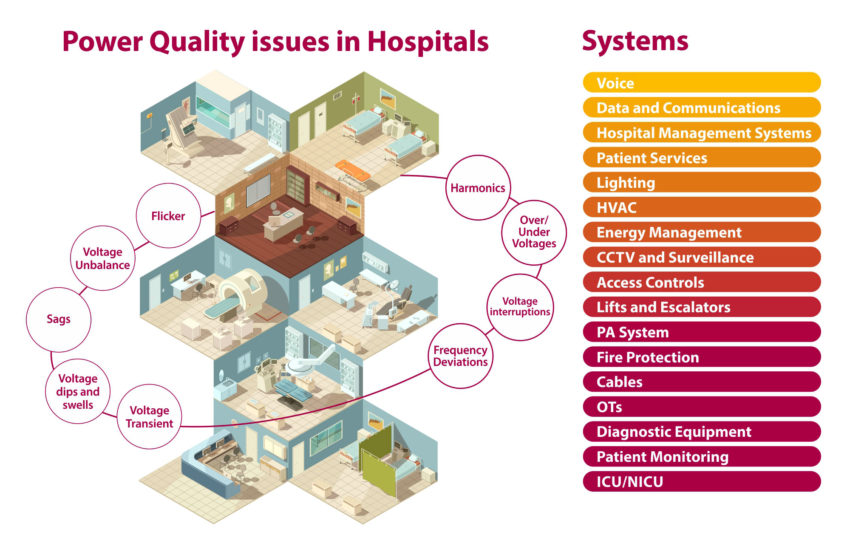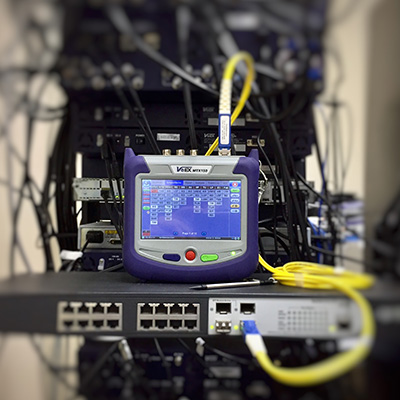Published On: Jul 29, 2019
This blog outlines the dominant problems that are faced by healthcare facilities including ancillary systems like diagnostic facilities due to poor power quality.
INTRODUCTION
Healthcare facilities are characterised by some of the most diverse electrical and electronic loads in any facility. Starting from computers, lighting to equipment for food, laundry, gas supplies to the highly sensitive medical diagnostic equipment, there is a wide variety of electrical loads in the hospitals and healthcare facilities. Also, a characteristic is that most of the healthcare facilities operate on a full load from the very first day. Overall, this creates an environment where power quality issues can surface frequently. Unlike other facilities, healthcare facilities are far more sensitive to power quality issues as even the slightest downtime can pose a big risk to the patient’s health.
For instance, an power outage due to under voltage lasting for just a few milliseconds and leading to malfunctioning of a cardiovascular instrument during the surgery can turn to be fatal for the patient. On the other end, instances such as the rising cases of fire in Neo-natal Intensive Care Units of hospitals, especially the incubator units, with root causes often traced to short circuit, overheating etc. electrical systems indicate the increased risk due to poor power quality. Above all, power quality issues emanating from electromagnetic devices are now even a bigger concern as they have started to impact the diagnostic capabilities and functioning of the medical Equipment itself. However, in spite of such a wide-ranging risks to the facility’s functioning, not enough attention is paid to address power quality issues.
CHALLENGES IN HEALTHCARE FACILITIES DUE TO PQ ISSUESTypically, electrical disturbances in general, including those due to poor PQ, are commonly associated with anomalies in earthing, grounding and gaps in other power distribution systems. While these disturbances tend to damage sensitive equipment, the errors too can be eliminated with proper diagnosis. However, in the case of healthcare facilities, there are several other factors that tend to create PQ issues, even when the basic electrical network is perfect. These factors, such as voltage transients or power factor, are a result of normal functioning of the modern day healthcare facilities. Continuous addition of advanced and sensitive electronics, electromagnetic units, and automation in medical, functional and support infrastructure is placing new challenges in healthcare facilities. |
While the electromagnetic field interruptions were not a dominant concern in healthcare in the past, with growing building automation in hospitals, sophisticated medical diagnosis, increased use of microprocessors and electronic storage of patient data, the effects of electrical disturbances are more visible today.
The table below, represented from a research study, shows how poor electrical power quality can affect medical devices in the Hospital.
Source: Investigations of the Quality of Hospital Electric Power Supply and the Tolerance of Medical Electric Devices to Voltage Dips Eisuke Hanada, Shuuya Itoga, +1 author Takato KudouPublished in Journal of Medical Systems 2007
DOI:10.1007/s10916-007-9058-z
Given below are some of the general and critical challenges that Healthcare facilities face due to poor Power Quality.
-
Display distortions
Several medical devises use CRT, LCD or LED based digital displays. The screens display vital diagnostic information about the patient’s condition, often in run-time. The diagnosis output is also taken in print format such as X-Rays, CT Scan Reports etc. The decisions are made on visual inspection and therefore any distortion in display output poses threat to the accuracy of diagnosis itself. The PQ issues such as over voltage or inrush currents typically affect the DC voltages powering the displays. Also, malfunctioning of micro-processors, data loss from memory of the equipment can lead to distortion of display or the print output.
It is not uncommon for the medical staff to get outputs with white patches on X-ray reports or poor resolution of output in CT scans or other such issues. Also, the data acquisition, processing and rendering time of the medical device can increase significantly due to excessive electromagnetic disturbances affecting the power storage and data processing units. All these leads to repeat of the test and adds to hassles for the patient and loss of revenue for the healthcare facility. While these issues are reported by the supporting medical staff, it is observed that the resolution rates remain low.
-
Device lockup
Lock-up or hang-up of devices is one of the most common issues arising in medical devices due to poor PQ. The electrical disturbances starting from harmonic distortion, leakage currents, over or under voltage instances adversely affect the micro-processor based medical devices and lead to lock-ups. Data losses are also observed in several instances.
The lock-up of life or emergency support systems when they are being used on the patient are fatal and can cost the hospital in loss of reputation and penalties. Rebooting of certain medical devices may take anywhere from several minutes to hours. Frequent rebooting can lead to corrupt software and other damages to electronics, which leads to additional maintenance costs, and loss of revenue from downtime.
-
Data losses
With almost every piece of data in hospitals is accessed, stored, retrieved and analysed digitally, the risk of data losses, especially due to electrical disturbances looms large. This applies to a wide range of data includes the administrative and billing data from hospital management system, the data stored in medical diagnostic devices or medical grade computers attached to these devices to EMRI or compliance records. The loss of data due to PQ issues is relatively difficult to detect. There have also been instances where the data loss has meant re-run of the test, increasing costs and delay in treatment.
Data losses in healthcare environment mostly a result of rapid frequency variation which involves a change in frequency from the normal or stable utility frequency of 50 or 60 Hz. The frequency variations are a result of sudden changes in electrical power such as emergency generators or unstable power sources. The frequency variations are particularly fatal to the sensitive electronic equipment as it induces failure of programs and alleviate the risk of data loss.
-
Adverse impact on medical procedures
The dependency on electronic devices in medical procedures is on the rise. The use of remotely operated robot based surgeries, or laparoscopic procedures, Laser based eye surgeries etc. are prominent examples of this trend. The threat from poor PQ causing equipment lock-ups, disturbances or general interruptions adversely affect the medical procedures. Depending on the interruption and its timing, the medical practitioners face variety of challenges. For instance, a fault in video footage in laparoscopic surgery will require an additional incision procedure thereby increasing the procedure and recovery time of the patient.
Most medical procedures require highly calibrated devices that respond precisely as per the patient care needs. Starting from the basic pumps to the modern day electronic based implants, the response of a medical device is critical when performing the procedure. PQ issues can alter the responses of sensitive devices owing to frequency variation, voltage surge or dips leading to loss of control or complete malfunction resulting from heating induced by over-current. Triggering of false alarms or no alarms in medical devices due to electrical disturbances form poor PQ are also common. The use of batteries offers no protection from malfunctioning of alarms as PQ instances such as voltage transients directly affect the controls of the devices. SOURCES OF POOR PQ IN MEDICAL FACILITIESSeveral factors starting from lack of awareness on how PQ issues impact the electrical network to the constraints in operating conditions, can be counted in sources or reasons behind poor PQ. |
The article, published on APQI.org, on PQ issues in developing countries helps to develop an understanding. However, some specific aspects listed below tend to affect the PQ more than others:
-
Upgrade or modifications of equipment or facilities
With the constant evolution of diagnostic and patient care technologies, expansion and upgrade of medical or facility devices is very common in healthcare facilities. However, most often, sparse attention is paid to upgrade the electrical infrastructure of the facility to align to the new needs of the added or upgraded devices. Problems in functioning of the devices, surfacing immediately after the installation is almost a sure indication of the shift in the PQ dynamics and must be addressed comprehensively.
Small things such as proper checking of earthing and grounding comparability, cable connections etc. also make a big difference when it comes to ensuring good PQ with upgrade of equipment. PQ issues are common with addition of high-wattage equipment such as CT Scanners. Use of good high quality Earthing with Copper to avoid breach of grounding to sensitive diagnostic devices go a long way in protection of devices. Audits, proactive monitoring of PQ parameters in early stages of operation help to diagnose and reduce risks from poor PQ.
PQ Issues observed – Voltage spikes, Voltage Swells, Voltage unbalance, Brownouts, Increased Electrical Noise
-
Activation of emergency power or back-up power and power switching
Emergency and back-up power activation is likely to trigger frequency variations which adversely affect the functioning of sensitive devices such as 4D Doppler Ultrasonic Scan Machines. Another common phenomenon is that of power switching observed in case of capacitor switching to improve the Power Factor (PF). The transients and other electrical disturbances enter the power distribution network due to poor PF of the facility. Routine activities such as circuit breakers, voltage stabilization devices, solutions such as UPS etc. also responsible for poor PQ instances in the electrical network. Here too, use of high quality distribution systems such as compact busbar system are helpful in achieving highly reliable electricity distribution.
PQ issues observed: Voltage variation, very short interruption, Voltage dips and under voltage, voltage variation
-
Ensuring equipment’s resilience to PQ issues
Built-in or external protections against poor PQ events in medical devices are often not accurately known. While many of the equipment manufacturers take measures to offer built-in protection against the electrical disturbances, these may not be always enough. Also, the level and scope of protective devices to mitigate PQ issues has to be addressed right from the design stage due to its dependency on site conditions. Also the supporting ecosystem plays a vital role. For instance, use of Copper based isolation transformer helps to maintain equipment integrity during operation.
Continuous monitoring of PQ events at the equipment locations along with manufacturer’s guidelines and standards followed in electrical network design help to mitigate the risks.
CONCLUSION
As healthcare facilities advance on multi-faceted technological frontiers in every function, the need for improved PQ is even more critical for reliable delivery of services. Given the diverse nature of PQ parameters, solutions to poor PQ will also have to be multi-faceted.
The healthcare facilities of the future are expected to be more and more transparent and traceable. This requires ensuring the highest level of reliability and safety in delivering patient care. Given the central and increasing role that electricity has to play in functioning of every process within the modern healthcare facility, reliable and safe electrical power is of utmost importance. Good PQ is central to achieving safe and clean electrical power and therefore cannot be ignored anymore.
REFERENCES
- Power Quality in Clinical Facilities https://link.springer.com/article/10.1007/s10916-005-7982-3
- http://digitalhealthage.com/the-risk-poor-power-quality-presents-to-healthcare/
- Power quality in the medical sector – https://www.medicalplasticsnews.com/news/opinion/power-quality-in-the-medical-sector/
- https://www.ecmweb.com/content/power-quality-problems-health-care-facilities
- Power Quality Issues in Healthcare Centre Keerti Kulkarni and Vinay Janardhan Shetty – http://inpressco.com/wp-content/uploads/2014/06/Paper1151806-1809.pdf
- When Power Quality is Life and Death by Fluke Corporation –https://www.fluke.com/es-es/informacion/blog/calidad-de-la-energia-electrica/case-study-when-power-quality-is-life-or-death









